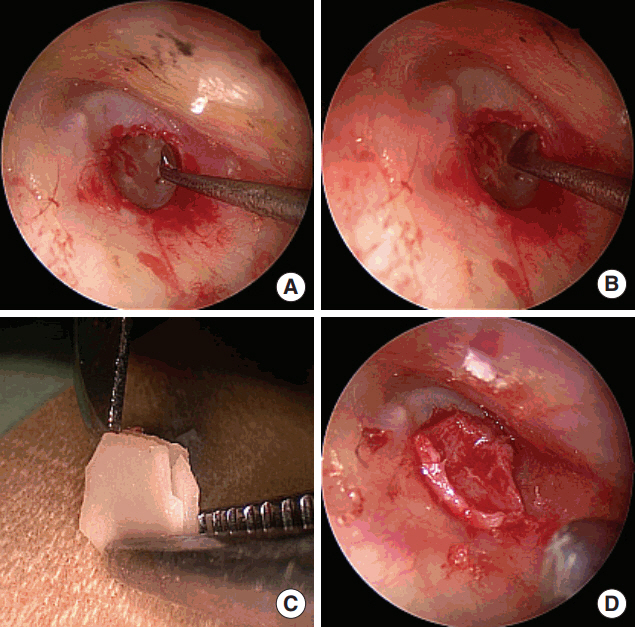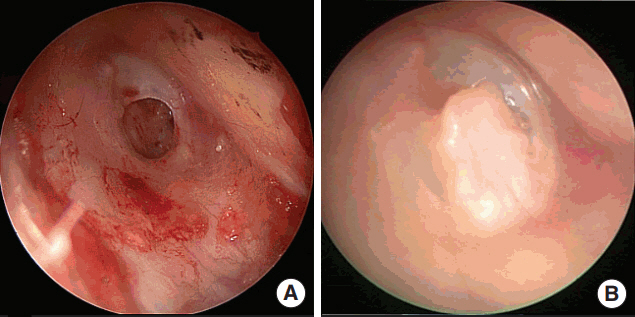Clin Exp Otorhinolaryngol.
2018 Mar;11(1):23-29. 10.21053/ceo.2017.00549.
Butterfly Cartilage Tympanoplasty Long-term Results: Excellent Treatment Method in Small and Medium Sized Perforations
- Affiliations
-
- 1Department of Otorhinolaryngology, Ege University School of Medicine, Izmir, Turkey. drmuratbenzer@gmail.com
- KMID: 2407788
- DOI: http://doi.org/10.21053/ceo.2017.00549
Abstract
OBJECTIVES
The aim of this study was to evaluate and report the long-term results of the butterfly cartilage tympanoplasty. Short-term and long-term hearing outcomes were compared according to age and perforation location as well.
METHODS
Ninety-three patients who were diagnosed with noncomplicated chronic otitis media and underwent microscopic transcanal butterfly cartilage tympanoplasty due to anterior, posterior, and central tympanic membrane perforation were included. Age, gender, follow-up time, pre- and postoperative pure tone audiometry thresholds (both air and bone conduction), pre- and postoperative air-bone gaps (ABGs), if any residual perforation was noted.
RESULTS
At the end of the follow-up period, successful closure occurred in 88 of 93 patients and success rate is 94.6%. In all patients, including those with residual perforations, the mean preoperative bone conduction threshold was 15.9 dB (range, 5 to 50 dB) among all groups whereas mean air conduction threshold was 36.4±15.1 dB (range, 10 to 90 dB) preoperatively and 28.8±14.3 dB in 6th month follow-up and 24.9±14.1 dB 24th month follow-up. Preoperative mean ABG was 22.1±7.1 dB (range, 5 to 40 dB) whereas 13.3±5.9 dB 6 months after surgery and 11.9±5.5 dB 24 months after surgery. There was a significant difference between pre- and postoperative ABG in both 6th and 24th month follow-up (P(6 mo-24 mo) < 0.05). Furthermore, preoperative mean air conduction differed significantly from postoperative 6th and 24th month follow-up mean air conduction thresholds (P < 0.05).
CONCLUSION
We suggested that butterfly cartilage tympanoplasty can be safely performed in small, moderate, and even large perforations, as the hearing outcomes and successful closure rate are similar to those of other surgical methods. Moreover, it can be performed under local anaesthesia and it has low complication rates.
MeSH Terms
Figure
Reference
-
1. Zollner F. The principles of plastic surgery of the sound-conducting apparatus. J Laryngol Otol. 1955; Oct. 69(10):637–52.2. Wullstein H. Theory and practice of tympanoplasty. Laryngoscope. 1956; Aug. 66(8):1076–93.
Article3. Kim HJ, Kim MJ, Jeon JH, Kim JM, Moon IS, Lee WS. Functional and practical outcomes of inlay butterfly cartilage tympanoplasty. Otol Neurotol. 2014; Sep. 35(8):1458–62.
Article4. Eavey RD. Inlay tympanoplasty: cartilage butterfly technique. Laryngoscope. 1998; May. 108(5):657–61.
Article5. Dornhoffer JL. Hearing results with cartilage tympanoplasty. Laryngoscope. 1997; Aug. 107(8):1094–9.
Article6. Kartush JM. Tympanic membrane Patcher: a new device to close tympanic membrane perforations in an office setting. Am J Otol. 2000; Sep. 21(5):615–20.7. Alain H, Esmat NH, Ohad H, Yona V, Nageris BI. Butterfly myringoplasty for total, subtotal, and annular perforations. Laryngoscope. 2016; Nov. 126(11):2565–8.
Article8. Ghanem MA, Monroy A, Alizade FS, Nicolau Y, Eavey RD. Butterfly cartilage graft inlay tympanoplasty for large perforations. Laryngoscope. 2006; Oct. 116(10):1813–6.
Article9. Bhattacharya SN, Pal S, Saha S, Gure PK, Roy A. Comparison of a microsliced modified chondroperichondrium shield graft and a temporalis fascia graft in primary type I tympanoplasty: a prospective randomized controlled trial. Ear Nose Throat J. 2016; Jul. 95(7):274–83.10. Mauri M, Lubianca Neto JF, Fuchs SC. Evaluation of inlay butterfly cartilage tympanoplasty: a randomized clinical trial. Laryngoscope. 2001; Aug. 111(8):1479–85.
Article11. Glasscock ME 3rd, Jackson CG, Nissen AJ, Schwaber MK. Postauricular undersurface tympanic membrane grafting: a follow-up report. Laryngoscope. 1982; Jul. 92(7 Pt 1):718–27.
Article12. Wu PW, Wang WH, Huang CC, Lee TJ, Huang CC. Comparison of short- and long-term hearing outcomes of successful inlay cartilage tympanoplasty between small and large eardrum perforations. Clin Exp Otorhinolaryngol. 2015; Dec. 8(4):359–63.
Article13. Riss JC, Roman S, Morredu E, Farinetti A, Nicollas R, Triglia JM. Butterfly-cartilage tympanoplasty in children: a 28-case series and literature review. Eur Ann Otorhinolaryngol Head Neck Dis. 2016; Jun. 133(3):179–82.
Article14. Ulku CH. Inlay butterfly cartilage tympanoplasty: anatomic and functional results. Indian J Otolaryngol Head Neck Surg. 2017; Feb. 14. [Epub]. https://doi.org/10.1007/s12070-017-1097-2.
Article15. Mehta RP, Rosowski JJ, Voss SE, O’Neil E, Merchant SN. Determinants of hearing loss in perforations of the tympanic membrane. Otol Neurotol. 2006; Feb. 27(2):136–43.
Article16. Park H, Hong SN, Kim HS, Han JJ, Chung J, Suh MW, et al. Determinants of conductive hearing loss in tympanic membrane perforation. Clin Exp Otorhinolaryngol. 2015; Jun. 8(2):92–6.
Article17. Tos M. Tympanoplasty and age. Arch Otolaryngol. 1972; Dec. 96(6):493–8.
Article18. Kessler A, Potsic WP, Marsh RR. Type 1 tympanoplasty in children. Arch Otolaryngol Head Neck Surg. 1994; May. 120(5):487–90.
Article19. Rozendorn N, Wolf M, Yakirevich A, Shapira Y, Carmel E. Myringoplasty in children. Int J Pediatr Otorhinolaryngol. 2016; Nov. 90:245–50.
Article
- Full Text Links
- Actions
-
Cited
- CITED
-
- Close
- Share
- Similar articles
-
- Microscopic versus Endoscopic Inlay Butterfly Cartilage Tympanoplasty
- Comparison of Short- and Long-term Hearing Outcomes of Successful Inlay Cartilage Tympanoplasty Between Small and Large Eardrum Perforations
- The Results of Myringoplasty Using Cartilage Butterfly Technique(Inlay Tympanoplasty)
- Cartilage-Perichondrium Tympanoplasty for Pediatric Atelectatic Ears
- Change of Middle Ear Mechanics after Tympanoplasty Type I with Thin Sliced Cartilage Island




